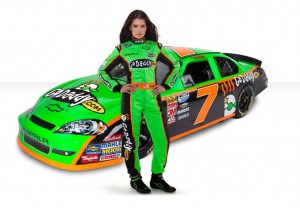
Want to crack a joke about this woman driver? Danica Patrick made the big jump to the typically good-ol'-boy NASCAR circuit.
As this month’s presidential election clearly demonstrated, there’s a significant demographic shift taking place in America – and you don’t have to check the voter rolls to confirm that. Simply look around you on the highway.
While women drivers may still be a subject that comedians feed upon, the fact is that the joke is now on men. More woman than men now have driver’s licenses, according to a new study by the University of Michigan’s Transportation Research Institute, or UMTRI.
The gap is expected to only continue widening, with the study showing that the number of Americans with a driver’s license has been shrinking over the past 15 years, the rate of decline for men among 25 to 29 year olds has been twice as large as for women.
“The changing gender demographics will have major implications on the extent and nature of vehicle demand, energy consumption, and road safety,” forecast Michael Sivak, co-author of the study.
On the other hand, a separate UMTRI study might give hope to male comics, cautioning that women may not always be as safe behind the wheel.
While women still hadn’t earned the right to vote in most of the country by the time Henry Ford rolled out his first Model T, efforts to keep women off the road gained little momentum during the early 20th Century, notes Margaret Walsh, author of Gender and the Automobile in the United States.
Nonetheless, “They were numerically in the minority,” writes Walsh, “and men often ridiculed their driving.” More importantly, she adds, “Women, like men, could see the advantages of freer movement.”
From an inconsequential minority, millions of women had passed the driving test by the 1950s – though in the Eisenhower era, when women were expected to stay home and raise a family, only half of those reaching driving age had yet received a license.
But as the idea of women’s lib began to take hold, the trend shifted into gear. By 1995, the number of women with a license lagged only slightly behind men, 87.4 million to 89.2 million. And the gap reversed itself by 2010, with 105.7 million licensed American women compared to 104.3 million men.
The UMTRI study finds the gap varies by age. There’s been a notable decline in the number of teens getting their licenses lately. Nearly one in four 19-year-olds didn’t both as of 2008, the Michigan research group discovered in a study released last summer, compared to one in eight back in the ‘70s.
Meanwhile, the new UMTRI report shows that while the share of men between 25 and 29 getting licenses has dropped 10.6% over the last 15 years, it has fallen just 4.7% among women.
Among older drivers, however, men still dominate. That likely reflects the fact that there are slightly more men born in the U.S. than women by a ratio of 105 to 100. But the ladies catch up after the age of 70 when men typically begin to die off sooner – at an average 75 compared to 80 years for women. The UMTRI study also shows older women hanging onto their licenses longer.
Margaret Dunning landed in the headlines after turning 102, earlier this year – and still driving the Packard 740 Roadster she has had for 82 years. Describing herself as “just a farm girl,” she learned how to drive at eight and was officially licensed by 12, after her father died.
If men outnumber women why are they more likely to lose interest in getting a license? Experts point to a variety of factors including economics; vehicles have become far more costly, especially for insurance, in recent years.
Sivak suggests that the rise of the Internet and the increased use of smartphone technology may also be at play. ““Virtual contact,” he contends, “reduces the need for actual contact.”
On the other hand, women may see getting a license and a car as a sign of liberation.
In the days when male comics dominated the comedy clubs, film and TV, simply mentioning a woman driver could get the audience snickering. Today, women comics are as likely as not to turn the tables.
But who’s really likely to be the better driver? Various studies come up with conflicting results.
A 2011 UMTRI study published in the journal Traffic Injury Prevention found that female drivers are far more likely to run into one another at a far higher rate than pure random chance would suggest. Crashes involving two women were “over-represented,” according to Sivak.
Then again, a 2011 MetLife Auto & Home American Safety Pulse Poll found women getting fewer tickets for reckless driving, winding up with fewer address for driving under the influence and – perhaps most notably – winding up dying in accidents about 50% less often.
Despite all those bad jokes, it seems, most women recognize who’s doing a better job on the road. According to the new MetLife survey, a full 51% believe they’re better drivers, only 25% pointing to men – the rest being undecided. Among males included in the survey, the sad truth has apparently sunk in, just 39% claiming they ruled the roads, with 26% pointing to the distaff side.
